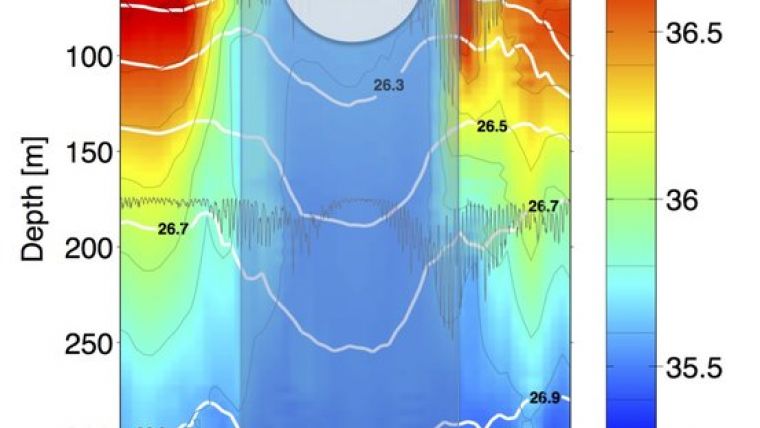Extremely Low-oxygen Eddies in the Atlantic Produce Greenhouse Gases
In 2014, an international research team led by the Kiel Cluster of Excellence ‘The Future Ocean’ and the GEOMAR Helmholtz Centre for Ocean Research Kiel was able to investigate in detail eddies in the Atlantic Ocean which were characterised by extremely low oxygen concentrations. The interdisciplinary analysis of the data and samples has revealed processes which were not previously known to occur in the Atlantic. This also includes the natural production of considerable amounts of greenhouse gases, as the team has now published in the international scientific journal, 'Scientific Reports'.
Oxygen in the seawater is not only vital to most marine organisms, its concentrations also affect the chemistry of the ocean and that of the atmosphere above. In oceanic regions with very little oxygen, for example, large amounts of the potent greenhouse gas nitrous oxide, also called laughing gas, are produced via biogeochemical processes and can then be released to the atmosphere.
Even though a natural moderate oxygen minimum zone (OMZ) exists along some of the eastern boundaries of the Atlantic Ocean, the Atlantic OMZ, unlike the OMZs of the Indian and Pacific oceans, was not considered to be a region of extremely low oxygen concentrations. New findings by an international research team led by the Kiel Excellence Cluster “Future Ocean” and the GEOMAR Helmholtz Center for Ocean Research Kiel, however, now imply that this picture has to be corrected. This study was published yesterday in the Nature Publishing Group journal Scientific Reports.
Ocean Eddies
Extreme low oxygen concentrations occur in the Atlantic in ocean eddies of up to 100 kilometres in diameter, which migrate westward across the ocean from the West African coast. Such eddies are difficult to detect with conventional observation methods, and require a combination of satellite, glider and ship-based observations.
The first observation of a low oxygen eddy in the Atlantic Ocean, however, was detected by the Cape Verde Ocean Observatory, a project which includes an ocean observation mooring north of the Cape Verdean island of São Vicente. With the financial support of the Kiel Cluster of Excellence ‘The Future Ocean’, an interdisciplinary group of scientists waited for their next chance. It came in 2014: by means of satellite observation they discovered a potential low oxygen eddy, which formed off the coast of Mauritania and migrated towards Cape Verde. From there, the team deployed autonomous sensor carriers, so-called gliders, to intercept the eddy. As it approached the islands, the researchers were also able to take water samples directly from the eddy’s centre with the Cape Verdean research vessel Islandia.
Sample Taken
At the time of the investigation of the eddy, the German research vessel Meteor conducted a long planned expedition for the Collaborative Research Centre 754 Kiel off Cape Verde. They did sample the eddy. Afterwards the obtained data and water samples were evaluated physically, biogeochemically and biologically.
The latest study, now published in Scientific Reports, demonstrates that at the core of the eddy, the highest levels of the greenhouse gas nitrous oxide ever measured in the open Atlantic were found in only 100 metres of water depth. This can be attributed to processes that can deplete the plant nutrient nitrogen from the ocean, producing, among other things, nitrous oxide in large quantities, and further points out that scientists should now consider revising our understanding of the chemical cycles in the Atlantic.
More Information
Grundle, D.S., C.R. Löscher, G. Krahmann, M.A. Altabet, H.W. Bange, J. Karstensen, A. Körtzinger, B. Fiedler (2017): Low oxygen eddies in the eastern tropical North Atlantic: 2 Implications for N2O cycling. Nature.














